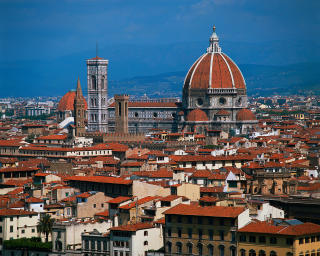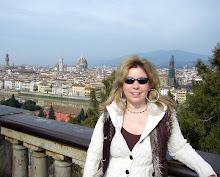



 The next morning, after having breakfast at our hotel, we boarded a ferry for the town of Varenna, a short ride away. This town has Roman roots, and is perhaps the most well-preserved medieval location on the lake. The streets here were even steeper than those in Bellagio, some impossibly so. The town is laid out with the 14th-century church, San Giorgo, as its centerpiece. It also has its own fortress high on a hill behind it, which at one time was manned to protect the town from invaders. The entire town is surrounded with quarries of black Varenna marble, which was used for the flooring of Milan’s cathedral.
The next morning, after having breakfast at our hotel, we boarded a ferry for the town of Varenna, a short ride away. This town has Roman roots, and is perhaps the most well-preserved medieval location on the lake. The streets here were even steeper than those in Bellagio, some impossibly so. The town is laid out with the 14th-century church, San Giorgo, as its centerpiece. It also has its own fortress high on a hill behind it, which at one time was manned to protect the town from invaders. The entire town is surrounded with quarries of black Varenna marble, which was used for the flooring of Milan’s cathedral.




 Varenna is not as popular with tourists as Bellagio, giving it a more authentic feel; it’s a true fishing village, evident by the fishing boats docked everywhere. The homes lining the steep lanes are an array of warm, earthy colors, adding to the charm of the town. And we pretty much had the place to ourselves, save for a few locals here and there. Heaven!
Varenna is not as popular with tourists as Bellagio, giving it a more authentic feel; it’s a true fishing village, evident by the fishing boats docked everywhere. The homes lining the steep lanes are an array of warm, earthy colors, adding to the charm of the town. And we pretty much had the place to ourselves, save for a few locals here and there. Heaven!


 There’s not a lot to do in Varenna, particularly at this time of year, but we were happy to discover that the terraced botanic gardens of the Hotel Villa Cipressi were open. Villa Cipressi was built decades ago as a private home. Today it is an upscale hotel and conference center. Its world-famous gardens contain a variety of plants and flowers, many in bloom even this early in the season. We thoroughly enjoyed our stroll along the garden’s paths, with their spectacular views over Lake Como. And, yes, we had the entire garden to ourselves!
There’s not a lot to do in Varenna, particularly at this time of year, but we were happy to discover that the terraced botanic gardens of the Hotel Villa Cipressi were open. Villa Cipressi was built decades ago as a private home. Today it is an upscale hotel and conference center. Its world-famous gardens contain a variety of plants and flowers, many in bloom even this early in the season. We thoroughly enjoyed our stroll along the garden’s paths, with their spectacular views over Lake Como. And, yes, we had the entire garden to ourselves! After enjoying the gardens, we headed back to catch a ferry back to Bellagio. On our way back we discovered that Varenna has its own Lido. I would love to return in the summer just to see these Lidos in full swing. Talk about retro!
After enjoying the gardens, we headed back to catch a ferry back to Bellagio. On our way back we discovered that Varenna has its own Lido. I would love to return in the summer just to see these Lidos in full swing. Talk about retro!Once back in Bellagio, and after having lunch at a small café, we took a self-guided walking tour put together by the Bellagio
 Tourist Office, “Historical Tour & Itinerary of the Central Part of the Town,” which we picked up on the dock. Our first stop was a stone column placed near the boat landing that shows how high the lake water rose during the devastating 1829 and 1868 floods. Chip did is best to put these heights in perspective. It’s hard to believe that the water could get this high!
Tourist Office, “Historical Tour & Itinerary of the Central Part of the Town,” which we picked up on the dock. Our first stop was a stone column placed near the boat landing that shows how high the lake water rose during the devastating 1829 and 1868 floods. Chip did is best to put these heights in perspective. It’s hard to believe that the water could get this high!

 Next we walked to the Grand Hotel Villa Serbelloni, which sits right at the lake’s edge. How would you like to lie out by this pool! This building was first built as a private residence in 1852 and became a hotel just 20 years later. Even though the hotel was not yet open for the season, we
Next we walked to the Grand Hotel Villa Serbelloni, which sits right at the lake’s edge. How would you like to lie out by this pool! This building was first built as a private residence in 1852 and became a hotel just 20 years later. Even though the hotel was not yet open for the season, we  were able to walk around inside. The walls were lined with photos of the famous people who have stayed here, including John F. Kennedy and Winston Churchill. We could see why this hotel was and continues to be such a draw. It’s magnificent!
were able to walk around inside. The walls were lined with photos of the famous people who have stayed here, including John F. Kennedy and Winston Churchill. We could see why this hotel was and continues to be such a draw. It’s magnificent!After leaving the hotel, we walked to the very tip of Bellagio, a promontory called the Punta Spartivento, which means “the point where the wind divides. It is at this exact point
 that Lake Como splits, and the views from here are spectacular.
that Lake Como splits, and the views from here are spectacular.Our next stop was Piazza San Giacomo, which is where St. James Basilica, with its beautiful bell tower, is located. This 11th-century church was declared
 a National Monument in 1904. We wondered why it took so long!
a National Monument in 1904. We wondered why it took so long!We continued on our walking tour, discovering the treasures of Bellagio along the way, including the city walls, once used as defense system; the Town Hall; another 11th-century church, St. George’s Chapel; Bellagio’s first hotel, the Hotel Metropole (originally the Hotel Genazzini), which opened in 1825; a plaque commemorating the Hungarian composer Franz Listz, who stayed in Bellagio in 1837; and the Villa Gotica, which was once an Anglican church but was converted into private apartments in the 1950s. I’m sure there was some controversy with that one!
 Needless to say, we had worked up an appetite, so we headed over to a place we had discovered earlier, the Enoteca Cava Turacciolo, a wine bar located in an 18th-century wine cellar. The walls were thick stone, making it cool year-round. Wine bottles sat on wooden shelves, and meats were hung from the ceilings to dry. The sounds of classical music filled the air. Had we discovered paradise?
Needless to say, we had worked up an appetite, so we headed over to a place we had discovered earlier, the Enoteca Cava Turacciolo, a wine bar located in an 18th-century wine cellar. The walls were thick stone, making it cool year-round. Wine bottles sat on wooden shelves, and meats were hung from the ceilings to dry. The sounds of classical music filled the air. Had we discovered paradise? The wine list here was substantial, with numerous wines from every region of Italy, most from small producers. We decided to stick with the region we were in, which is known as the Franciacorte region. As we asked questions, the owner explained all of the wines in great detail. We figured that either he really knew his stuff or that he was making it all up. Either way, we had a wonderful evening here, enjoying fine wine with perfect
The wine list here was substantial, with numerous wines from every region of Italy, most from small producers. We decided to stick with the region we were in, which is known as the Franciacorte region. As we asked questions, the owner explained all of the wines in great detail. We figured that either he really knew his stuff or that he was making it all up. Either way, we had a wonderful evening here, enjoying fine wine with perfect  culinary complements, and made plans to return the next evening. It was that good!
culinary complements, and made plans to return the next evening. It was that good!

No comments:
Post a Comment